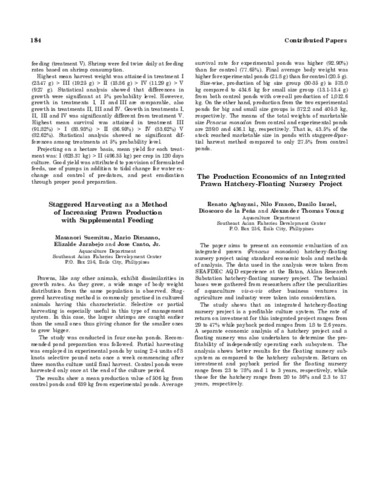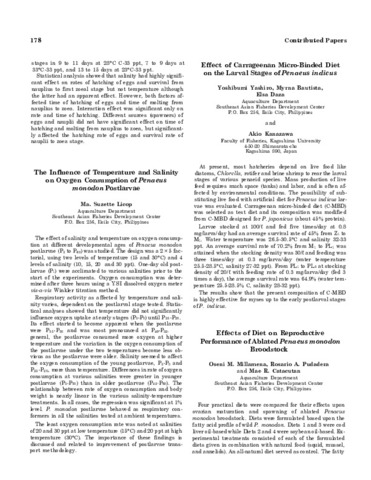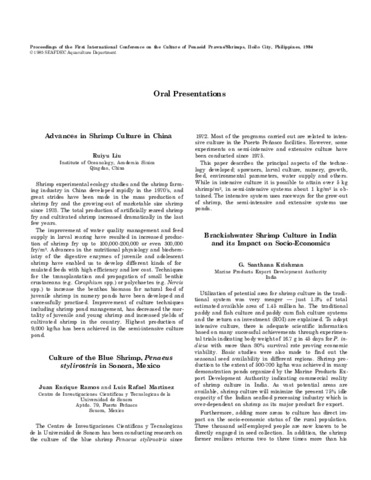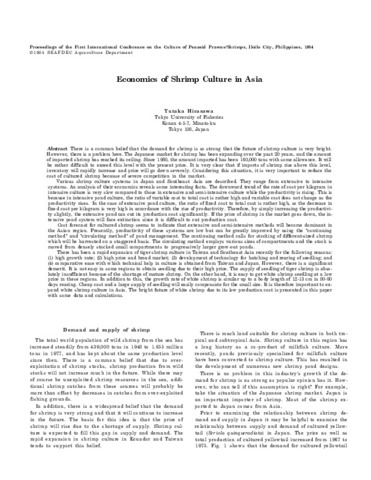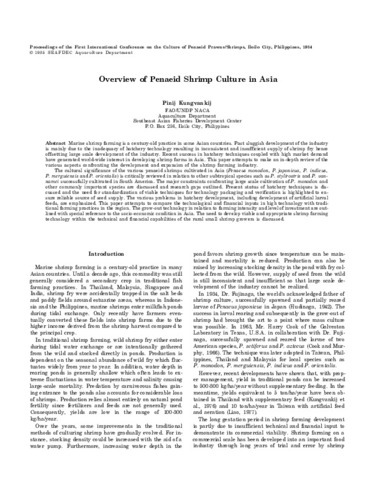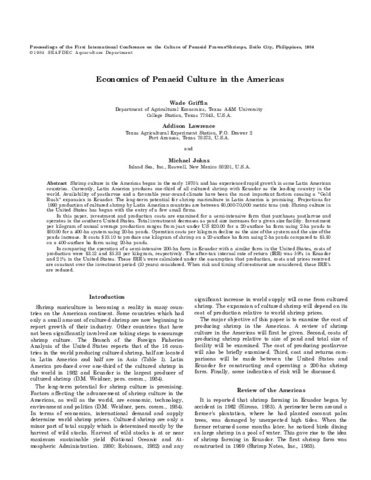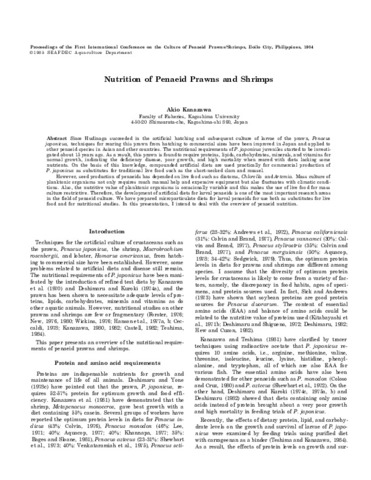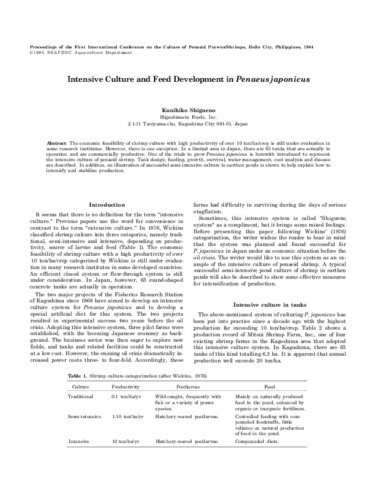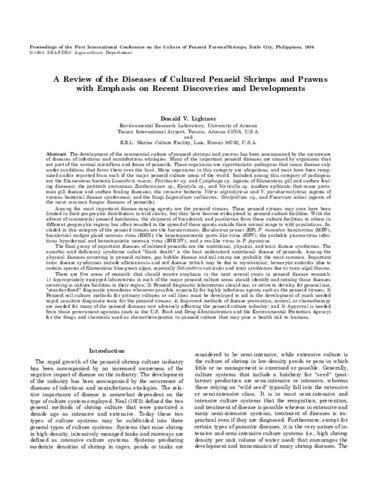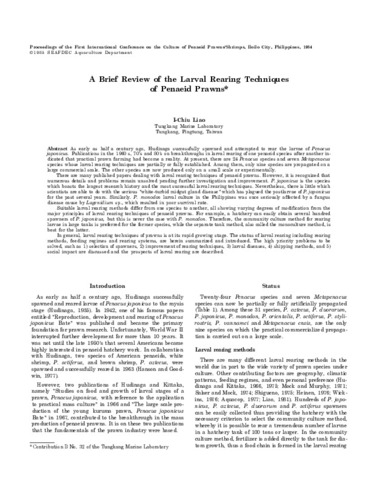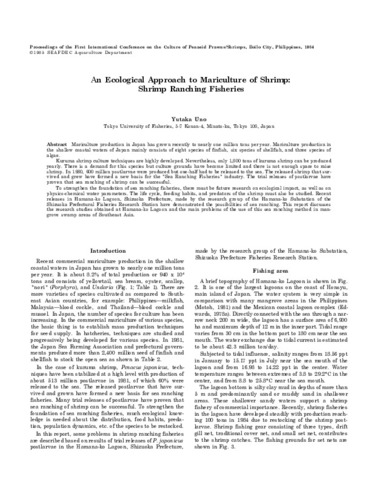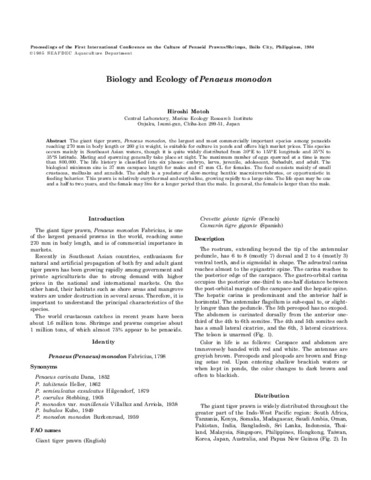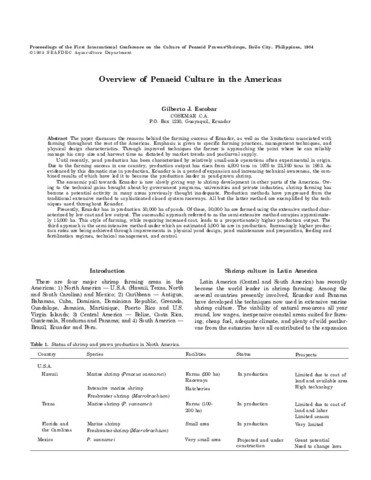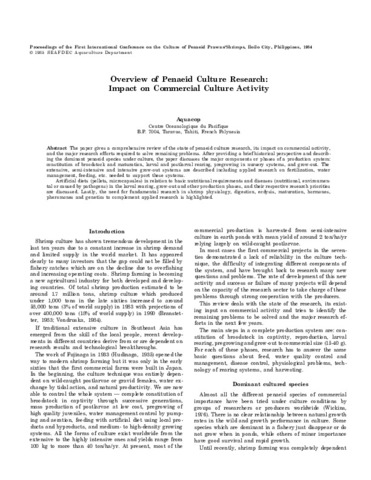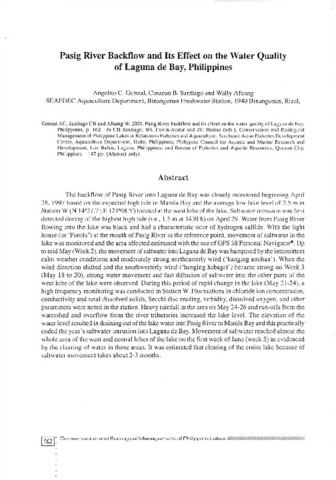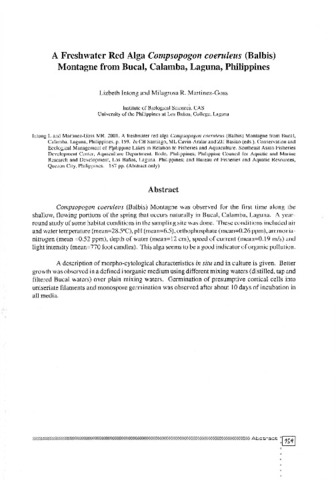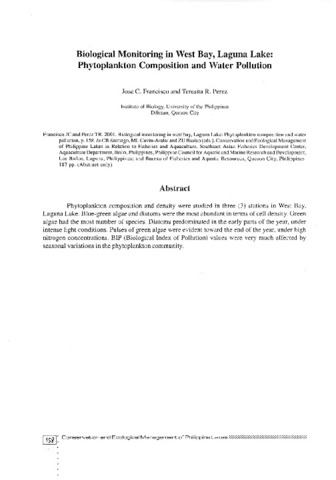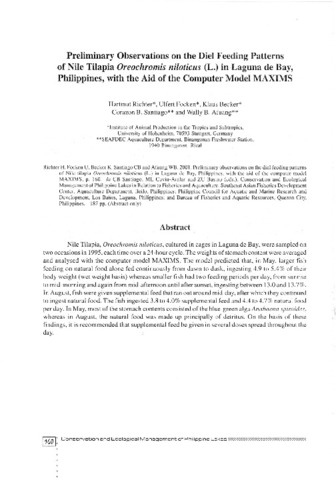Conference Proceedings: Recent submissions
Now showing items 501-520 of 767
-
The production economics of an integrated prawn hatchery-floating nursery project
(Aquaculture Department, Southeast Asian Fisheries Development Center, 1985)The paper aims to present an economic evaluation of an integrated prawn (Penaeus monodon) hatchery-floating nursery project using standard economic tools and methods of analysis. The data used in the analysis were taken ... -
Effects of diet on reproductive performance of ablated Penaeus monodon broodstock
(Aquaculture Department, Southeast Asian Fisheries Development Center, 1985)Four practical diets were compared for their effects upon ovarian maturation and spawning of ablated Penaeus monodon broodstock. Diets were formulated based upon the fatty acid profile of wild P. monodon. Diets 1 and 3 ... -
Advances in shrimp culture in China
(Aquaculture Department, Southeast Asian Fisheries Development Center, 1985)Shrimp experimental ecology studies and the shrimp farming industry in China developed rapidly in the 1970's, and great strides have been made in the mass production of shrimp fry and the growing-out of marketable size ... -
Economics of shrimp culture in Asia
(Aquaculture Department, Southeast Asian Fisheries Development Center, 1985)There is a common belief that the demand for shrimp is so strong that the future of shrimp culture is very bright. However, there is a problem here. The Japanese market for shrimp has been expanding over the past 20 years, ... -
Overview of penaeid shrimp culture in Asia
(Aquaculture Department, Southeast Asian Fisheries Development Center, 1985)Marine shrimp farming is a century-old practice in some Asian countries. Past sluggish development of the industry is mainly due to the inadequacy of hatchery technology resulting in inconsistent and insufficient supply ... -
Economics of penaeid culture in the Americas
(Aquaculture Department, Southeast Asian Fisheries Development Center, 1985)Shrimp culture in the Americas began in the early 1970's and has experienced rapid growth in some Latin American countries. Currently, Latin America produces one-third of all cultured shrimp with Ecuador as the leading ... -
Nutrition of penaeid prawns and shrimps
(Aquaculture Department, Southeast Asian Fisheries Development Center, 1985)Since Hudinaga succeeded in the artificial hatching and subsequent culture of larvae of the prawn, Penaeus japonicus, techniques for rearing this prawn from hatching to commercial sizes have been improved in Japan and ... -
Intensive culture and feed development in Penaeus japonicus
(Aquaculture Department, Southeast Asian Fisheries Development Center, 1985)The economic feasibility of shrimp culture with high productivity of over 10 ton/ha/crop is still under evaluation in some research institutes. However, there is one exception. In a limited area in Japan, there are 63 tanks ... -
A review of the diseases of cultured penaeid shrimps and prawns with emphasis on recent discoveries and developments
(Aquaculture Department, Southeast Asian Fisheries Development Center, 1985)The development of the commercial culture of penaeid shrimps and prawns has been accompanied by the occurrence of diseases of infectious and noninfectious etiologies. Many of the important penaeid diseases are caused by ... -
A brief review of the larval rearing techniques of penaeid prawns
(Aquaculture Department, Southeast Asian Fisheries Development Center, 1985)As early as half a century ago, Hudinaga successfully spawned and attempted to rear the larvae of Penaeus japonicus. Publications in the 1960 s, 70's and 80's on breakthroughs in larval rearing of one penaeid species after ... -
An ecological approach to mariculture of shrimp: Shrimp ranching fisheries
(Aquaculture Department, Southeast Asian Fisheries Development Center, 1985)Mariculture production in Japan has grown recently to nearly one million tons per year. Mariculture production in the shallow coastal waters of Japan mainly consists of eight species of finfish, six species of shellfish, ... -
Biology and ecology of Penaeus monodon
(Aquaculture Department, Southeast Asian Fisheries Development Center, 1985)The giant tiger prawn, Penaeus monodon, the largest and most commercially important species among penaeids reaching 270 mm in body length or 260 g in weight, is suitable for culture in ponds and offers high market prices. ... -
Overview of penaeid culture in the Americas
(Aquaculture Department, Southeast Asian Fisheries Development Center, 1985)The paper discusses the reasons behind the farming success of Ecuador, as well as the limitations associated with farming throughout the rest of the Americas. Emphasis is given to specific farming practices, management ... -
Overview of penaeid culture research: Impact on commercial culture activity
(Aquaculture Department, Southeast Asian Fisheries Development Center, 1985)The paper gives a comprehensive review of the state of penaeid culture research, its impact on commercial activity, and the major research efforts required to solve remaining problems. After providing a brief historical ... -
Pasig River backflow and its effect on the water quality of Laguna de Bay, Philippines
(Aquaculture Department, Southeast Asian Fisheries Development Center; Philippine Council for Aquatic and Marine Research and Development (PCAMRD), Department of Science and Technology; Bureau of Fisheries and Aquatic Resources, 2001)The backflow of Pasig River into Laguna de Bay was closely monitored beginning April 28, 1997 based on the expected high tide in Manila Bay and the average low lake level of 2.5 m in Station W (N 14°27.7'; E 121°08.5') ... -
A freshwater red alga Compsopogon coeruleus (Balbis) Montagne from Bucal, Calamba, Laguna, Philippines
(Aquaculture Department, Southeast Asian Fisheries Development Center; Philippine Council for Aquatic and Marine Research and Development (PCAMRD), Department of Science and Technology; Bureau of Fisheries and Aquatic Resources, 2001)Compsopogon coeruleus (Balbis) Montagne was observed for the first time along the shallow, flowing portions of the spring that occurs naturally in Bucal, Calamba, Laguna. A year-round study of some habitat conditions in ... -
Biological monitoring in west bay, Laguna Lake: Phytoplankton composition and water pollution
(Aquaculture Department, Southeast Asian Fisheries Development Center; Philippine Council for Aquatic and Marine Research and Development (PCAMRD), Department of Science and Technology; Bureau of Fisheries and Aquatic Resources, 2001)Phytoplankton composition and density were studied in three (3) stations in West Bay, Laguna Lake. Blue-green algae and diatoms were the most abundant in terms of cell density. Green algae had the most number of species. ... -
Species and proximate composition of Laguna de Bay phytoplankton cultured in three different nitrogen-phosphorus ratios and their utilization by Nile tilapia
(Aquaculture Department, Southeast Asian Fisheries Development Center; Philippine Council for Aquatic and Marine Research and Development (PCAMRD), Department of Science and Technology; Bureau of Fisheries and Aquatic Resources, 2001)Natural phytoplankton populations from Laguna de Bay were used in outdoor batch culture experiment in 1-ton capacity circular concrete tanks and 60-liter glass aquaria for a maximum duration of 72 days. The treatments ... -
Preliminary observations on the diel feeding patterns of Nile tilapia Oreochromis niloticus (L.) in Laguna de Bay, Philippines, with the aid of the computer model MAXIMS
(Aquaculture Department, Southeast Asian Fisheries Development Center; Philippine Council for Aquatic and Marine Research and Development (PCAMRD), Department of Science and Technology; Bureau of Fisheries and Aquatic Resources, 2001)Nile Tilapia, Oreochromis niloticus, cultured in cages in Laguna de Bay, were sampled on two occasions in 1995, each time over a 24-hour cycle. The weights of stomach content were averaged and analysed with the computer ... -
The decline of native fishes and fisheries and the rise of aquaculture in lakes and rivers in the Philippines
(Aquaculture Department, Southeast Asian Fisheries Development Center; Philippine Council for Aquatic and Marine Research and Development (PCAMRD), Department of Science and Technology; Bureau of Fisheries and Aquatic Resources, 2001)This paper reviews historical and recent data on biodiversity, fisheries, exotic fishes, and aquaculture in Philippine lakes and rivers. The country's lakes and rivers are poor in primary freshwater fishes because the ...

